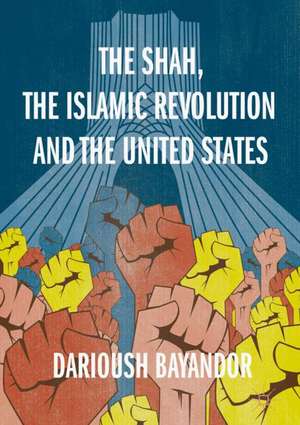The Shah, the Islamic Revolution and the United States
Autor Darioush Bayandoren Limba Engleză Hardback – 13 dec 2018
Preț: 713.84 lei
Preț vechi: 839.81 lei
-15% Nou
Puncte Express: 1071
Preț estimativ în valută:
136.60€ • 142.98$ • 113.69£
136.60€ • 142.98$ • 113.69£
Carte tipărită la comandă
Livrare economică 31 martie-14 aprilie
Preluare comenzi: 021 569.72.76
Specificații
ISBN-13: 9783319961187
ISBN-10: 3319961187
Pagini: 438
Ilustrații: XVIII, 438 p. 12 illus., 5 illus. in color.
Dimensiuni: 148 x 210 x 33 mm
Greutate: 0.89 kg
Ediția:1st ed. 2019
Editura: Springer International Publishing
Colecția Palgrave Macmillan
Locul publicării:Cham, Switzerland
ISBN-10: 3319961187
Pagini: 438
Ilustrații: XVIII, 438 p. 12 illus., 5 illus. in color.
Dimensiuni: 148 x 210 x 33 mm
Greutate: 0.89 kg
Ediția:1st ed. 2019
Editura: Springer International Publishing
Colecția Palgrave Macmillan
Locul publicării:Cham, Switzerland
Cuprins
I. The Pre-Revolution Setting.- 1. A Retrospective.- 2. Nezam Shahanshahi: The Shah's Imperial Order.- II. Onset of the Revolution.- 3. Downslide.- 4. The Opposition.- 5. Changing Tack (1976–1977).- III. The Revolution.- 6. 1977: The Year of All Dangers.- 7. The Spark (Spring 1978).- 8. Actors, Strategies and Structures.- 9. The Abadan File.- 10. Appeasement and Recoil.- 11. October Countdown.- 12. November Countdown.- 13. The Military Spell: Prime Minister Gholamreza Azhari.- 14. Carter's Quandry.- 15. The USSR and the Iranian Revolution.- 16. The Dawn of a New Era.- 17. The American Attempt at Dialogue with Ayatollah Khomeini.- 18. Swansongs.- 19. The Collapse.
Recenzii
“Meticulous and comprehensive, this newly released study of the 1979 revolution is a worthy addition to an already copious literature on Iran. … Bayandor provides a gripping chronicle of the forces that gave rise to a populist revolution and a theocratic post-revolutionary government.” (Brookings, brookings.edu, January, 2019)
‘”The Shah, the Islamic Revolution and the United States,’ offers a fresh perspective on the Shah of Iran’s rule and skillfully explains how the historical events that followed continue to shape Iran today. Working with previously untapp archival materials, Bayandor examines the sophisticated and often complex dynamics between domestic and international affairs in Iran.” (Kayhan Life, kayhanlife.com, February, 14 , 2019)
Notă biografică
Darioush Bayandor is a Swiss-Iranian scholar and a former diplomat and United Nations official. He is the author of Iran and the CIA: The Fall of Mosaddeq Revisited (Palgrave, 2010).
Textul de pe ultima copertă
The Islamic Revolution in 1979 transformed Iranian society and reshaped the political landscape of the Middle East. Four decades later, Darioush Bayandor draws upon heretofore untapped archival evidence to reexamine the complex domestic and international dynamics that led to the Revolution. Beginning with the socioeconomic transformation of the 1960s, this book follows the Shah’s rule through the 1970s, tracing the emergence of opposition movements, the Shah’s blunders and miscalculations, the influence of the post-Vietnam zeitgeist and the role of the Carter administration. The Shah, the Islamic Revolution and the United States offers new revelations about how Iran was thrown into chaos and an ailing ruler lost control, with consequences that still reverberate today.
Caracteristici
Offers a vivid history of the final decade of the Shah’s regime before the rise of the Islamic Republic in 1979 Draws upon a trove of untapped archival documents Examines the roots of the Islamic Revolution, offering a corrective to a number of widely accepted fallacies about Mohammad Reza Shah Pahlavi
